Feasibility and Potential Assessment of Solar Resources: A Case Study in North Shewa Zone, Amhara, Ethiopia
Abstract
1. Introduction
1.1. Motivation
1.2. Literature Review
1.3. Contributions
- Identify the locations of solar PV resource potential in the study areas.
- Determine the solar irradiation in kWh/m2/day in the study areas.
- Provide information of annual solar potential at different locations.
- Indicate the solar potential of the areas using map locations.
- Assess temperature in the study areas.
- Contribute knowledge implications.
- Determine the suitable solar potential location in urban, semi-urban, and rural areas.
- Mitigate the emission of greenhouse gas.
- Contribute to the world’s sustainable goal for the achievement of zero carbon release by 2050.
2. Materials and Methods
3. Study Area Descriptions
4. Result and Discussion
4.1. Assessment of Solar Potential Based on NASA Online Data
4.2. Solar Potential Analysis
5. Conclusions
Author Contributions
Funding
Data Availability Statement
Conflicts of Interest
Nomenclature
| Acronym | Definition |
| PA | Potential Assessment |
| DNI | Direct Normal Irradiation |
| GHI | Global Horizontal Irradiation |
| DIF | Diffuse Horizontal Irradiation |
| NMA | National Meteorology Agency |
| NASA | National Aeronautics and Space Administration |
| EMA | Energy Market Authority |
| PV | Photo Voltaic |
| EEP | Ethiopia Electric Power |
| HOMER | Hybrid Optimization of Multiple Energy Resources |
| GIS | Geographic Information System |
| ANFIS | Adaptive Neuro-Fuzzy Inference System |
| PVGIS | Photovoltaic Geographical Information System |
| SWERA | Solar Wind Energy Resource Assessment |
References
- Mugisha, J.; Ratemo, M.A.; Keza, B.C.B.; Kahveci, H. Assessing the opportunities and challenges facing the development of off-grid solar systems in Eastern Africa: The cases of Kenya, Ethiopia, and Rwanda. Energy Policy 2021, 150, 112131. [Google Scholar] [CrossRef]
- Tucho, G.T.; Weesie, P.D.; Nonhebel, S. Assessment of renewable energy resources potential for large scale and standalone applications in Ethiopia. Renew. Sustain. Energy Rev. 2014, 40, 422–431. [Google Scholar] [CrossRef]
- Kebede, M.H.; Beyene, G.B. Feasibility study of PV-wind-fuel cell hybrid power system for electrification of a rural village in Ethiopia. J. Electr. Comput. Eng. 2018, 2018, 4015354. [Google Scholar]
- Guta, D.D. Determinants of household adoption of solar energy technology in rural Ethiopia. J. Clean. Prod. 2018, 204, 193–204. [Google Scholar] [CrossRef]
- IRENA. Estimating the Renewable Energy Potential in Africa—A GIS-Based Approach; IRENA: Abu Dhabi, United Arab Emirates, 2014. [Google Scholar]
- Benti, N.E.; Aneseyee, A.B.; Asfaw, A.A.; Geffe, C.A.; Tiruye, G.A.; Mekonnen, Y.S. Estimation of global solar radiation using sunshine-based models in Ethiopia. Cogent Eng. 2022, 9, 2114200. [Google Scholar] [CrossRef]
- United Nations, Renewable Energy—Powering a Safer Future. Available online: https://www.un.org/en/climatechange/raising-ambition/renewable-energy (accessed on 2 January 2023).
- Dursun, E. Solar Energy Potential in Horn of Africa: A Comparative Study Using Matlab/Simulink. Balk. J. Electr. Comput. Eng. 2021, 9, 310–319. [Google Scholar] [CrossRef]
- Drake, F.; Mulugetta, Y. Assessment of solar and wind energy resources in Ethiopia. I. Solar energy. Sol. Energy 1996, 57, 205–217. [Google Scholar] [CrossRef]
- Beyene, G.E.; Kumie, A.; Edwards, R.; Troncoso, K. Opportunities for Transition to Clean Household Energy in Ethiopia: Application of the Household Energy Assessment Rapid Tool (HEART). 2018. Available online: https://www.who.int/publications/i/item/9789241514491 (accessed on 2 January 2023).
- Kruger, W.; Stuurman, F.; Alao, F. Ethiopia Country Report in Report 5: Energy and Economic Growth Research Programme (W01 and W05) PO Number PO00022908. 2019. Available online: https://www.gsb.uct.ac.za/files/Ethiopia_Country_Report.pdf (accessed on 2 January 2023).
- Hailu, E.; Salau, A.O.; Godebo, A.J. Assessment of solar energy potential of east gojjam zone Ethiopia using angestrom-prescott model. Int. J. Eng. Res. Afr. 2021, 53, 171–179. [Google Scholar] [CrossRef]
- Nebey, A.H.; Taye, B.Z.; Workineh, T.G. Site Suitability Analysis of Solar PV Power Generation in South Gondar, Amhara Region. J. Energy 2020, 2020, 3519257. [Google Scholar] [CrossRef]
- Lachore, W.L.; Biru, G. Feasibility Study and Design of Standalone Hybrid Power Generation System for Rural Area in Ethiopia: Case Study of Minjar-ShenkoraWoreda. Int. J. Renew. Energy Sources 2021, 6, 8–29. [Google Scholar]
- Teferra, D.M. Potential and feasibility study of standalone solar PV/wind/biogas and biodiesel hybrid electric supply system in Ethiopia. Int. J. Energy Technol. Policy 2017, 13, 368–377. [Google Scholar] [CrossRef]
- Aprilianti, K.P.; Baghta, N.A.; Aryani, D.R.; Jufri, F.H.; Utomo, A.R. Potential assessment of solar power plant: A case study of a small island in Eastern Indonesia. IOP Conf. Ser. Earth Environ. Sci. 2020, 599, 012026. [Google Scholar] [CrossRef]
- AbebeWorke, B.; Bludszuweit, H.; Domínguez-Navarro, J.A. Solar Radiation Estimation Using Data Mining Techniques for Remote Areas—A Case Study in Ethiopia. Energies 2020, 13, 5714. [Google Scholar] [CrossRef]
- Bekele, G. Study into the Potential and Feasibility of a Standalone Solar-Wind Hybrid Electric Energy Supply System; KTH Royal Institute of Technology: Stockholm, Sweden, 2009; Available online: http://kth.diva-portal.org/smash/record.jsf?pid=diva2%3A282919&dswid=8816 (accessed on 2 January 2023).
- Miad, A.M.A.; Mostafa, S.M.G.; Arafat, Y. Feasibility Analysis and Economic Impact Assessment of Microgrid Renewable Energy Systems in Burao, Somaliland. In Proceedings of the 2019 1st International Conference on Advances in Science, Engineering and Robotics Technology (ICASERT), Dhaka, Bangladesh, 3–5 May 2019; pp. 1–6. [Google Scholar]
- Akhtar, I.; Kirmani, S.; Jameel, M.; Alam, F. Feasibility Analysis of Solar Technology Implementation in Restructured Power Sector with Reduced Carbon Footprints. IEEE Access 2021, 9, 30306–30320. [Google Scholar] [CrossRef]
- Maliro, P.; Diarra, B.; Samikannu, R. Technical and economic feasibility assessment for a solar PV mini-grid for Matekenya village. Cogent Eng. 2022, 9, 2110707. [Google Scholar] [CrossRef]
- Kassem, Y.; Camur, H.; Abughinda, O.A. Solar energy potential and feasibility study of a 10MW grid-connected solar plant in Libya. Eng. Technol. Appl. Sci. Res. 2020, 10, 5358–5366. [Google Scholar] [CrossRef]
- Abnavi, M.D.; Mohammadshafie, N.; Rosen, M.A.; Dabbaghian, A.; Fazelpour, F. Techno-economic feasibility analysis of stand-alone hybrid wind/photovoltaic/diesel/battery system for the electrification of remote rural areas: Case study Persian Gulf Coast-Iran. Environ. Prog. Sustain. Energy 2019, 38, 13172. [Google Scholar] [CrossRef]
- Nacer, T.; Hamidat, A.; Nadjemi, O.; Bey, M. Feasibility study of grid connected photovoltaic system in family farms for electricity generation in rural areas. Renew. Energy 2016, 96, 305–318. [Google Scholar] [CrossRef]
- Iqbal, S.; Jan, M.U.; Rehman, A.U.; Shafiq, A.; Rehman, H.U.; Aurangzeb, M. Feasibility Study and Deployment of Solar Photovoltaic System to Enhance Energy Economics of King Abdullah Campus, University of Azad Jammu and Kashmir Muzaffarabad, AJK Pakistan. IEEE Access 2022, 10, 5440–5455. [Google Scholar] [CrossRef]
- Lobaccaro, G.; Lisowska, M.M.; Saretta, E.; Bonomo, P.; Frontini, F. A methodological analysis approach to assess solar energy potential at the neighborhood scale. Energies 2019, 12, 3554. [Google Scholar] [CrossRef]
- Bergamasco, L.; Asinari, P. Scalable methodology for the photovoltaic solar energy potential assessment based on available roof surface area: Application to Piedmont Region (Italy). Sol. Energy 2011, 85, 1041–1055. [Google Scholar] [CrossRef]
- Bódis, K.; Kougias, I.; Jäger-Waldau, A.; Taylor, N.; Szabó, S. A high-resolution geospatial assessment of the rooftop solar photovoltaic potential in the European Union. Renew. Sustain. Energy Rev. 2019, 114, 109309. [Google Scholar] [CrossRef]
- Chukwujindu, N.S. A comprehensive review of empirical models for estimating global solar radiation in Africa. Renew. Sustain. Energy Rev. 2017, 78, 955–995. [Google Scholar] [CrossRef]
- Assareh, E.; Jafarian, M.; Nedaei, M.; Firoozzadeh, M.; Lee, M. Performance Evaluation and Optimization of a Photovoltaic/Thermal (PV/T) System according to Climatic Conditions. Energies 2022, 15, 7489. [Google Scholar] [CrossRef]
- Guedri, K.; Salem, M.; Assad, M.E.H.; Rungamornrat, J.; Malek Mohsen, F.; Buswig, Y.M. PV/Thermal as Promising Technologies in Buildings: A Comprehensive Review on Exergy Analysis. Sustainability 2022, 14, 12298. [Google Scholar] [CrossRef]
- Aslam, A.; Ahmed, N.; Qureshi, S.A.; Assadi, M.; Ahmed, N. Advances in Solar PV Systems; A Comprehensive Review of PV Performance, Influencing Factors, and Mitigation Techniques. Energies 2022, 15, 7595. [Google Scholar] [CrossRef]
- Solar constant. Available online: https://en.wikipedia.org/wiki/Solar_constant (accessed on 2 January 2023).
- Wang, Z. Design of Solar Thermal Power Plants; Academic Press: Cambridge, MA, USA, 2019; pp. 417–424. ISBN 9780128156131. [Google Scholar] [CrossRef]
- Available online: https://globalsolaratlas.info/map/c=9.637307,39.37912,9&s=9.811916,39.556274&m=site (accessed on 2 January 2023).
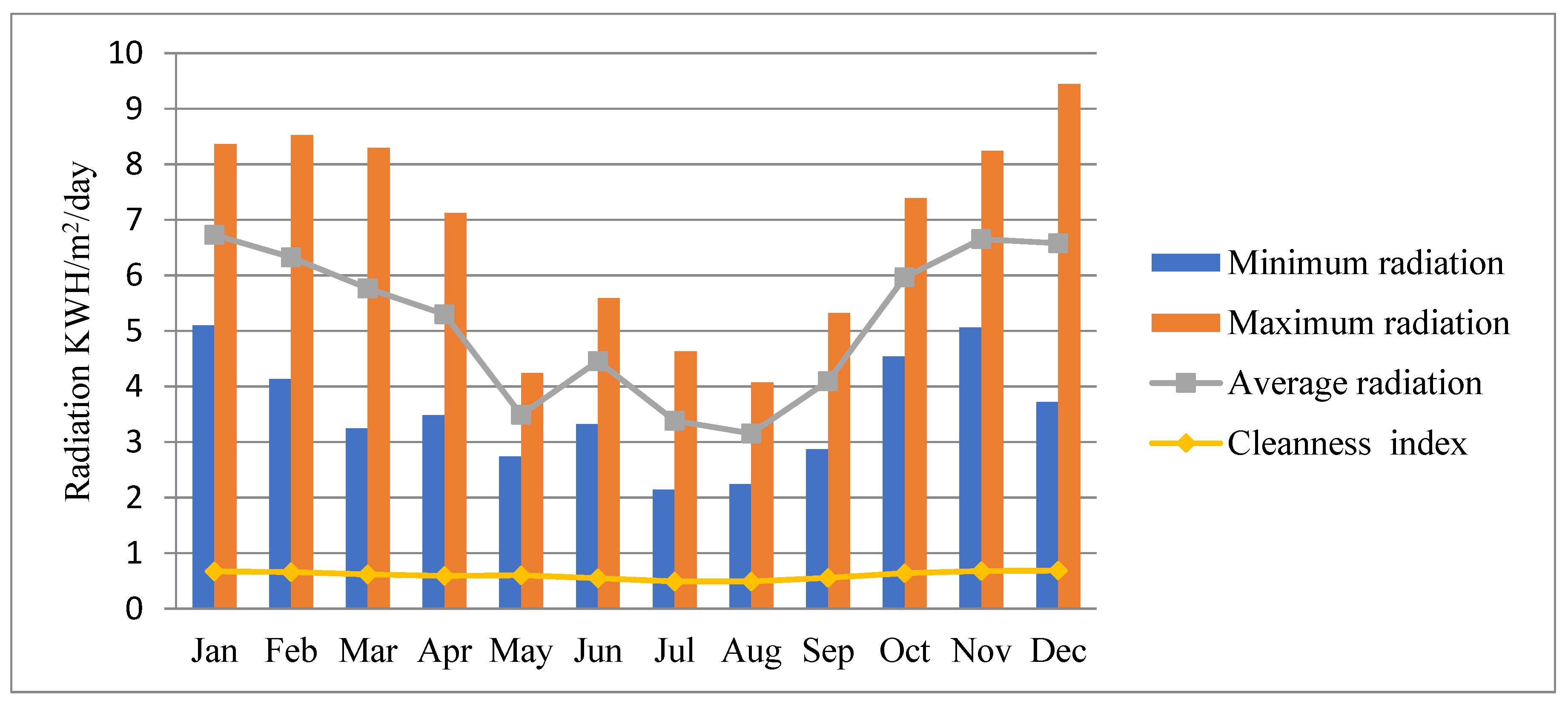
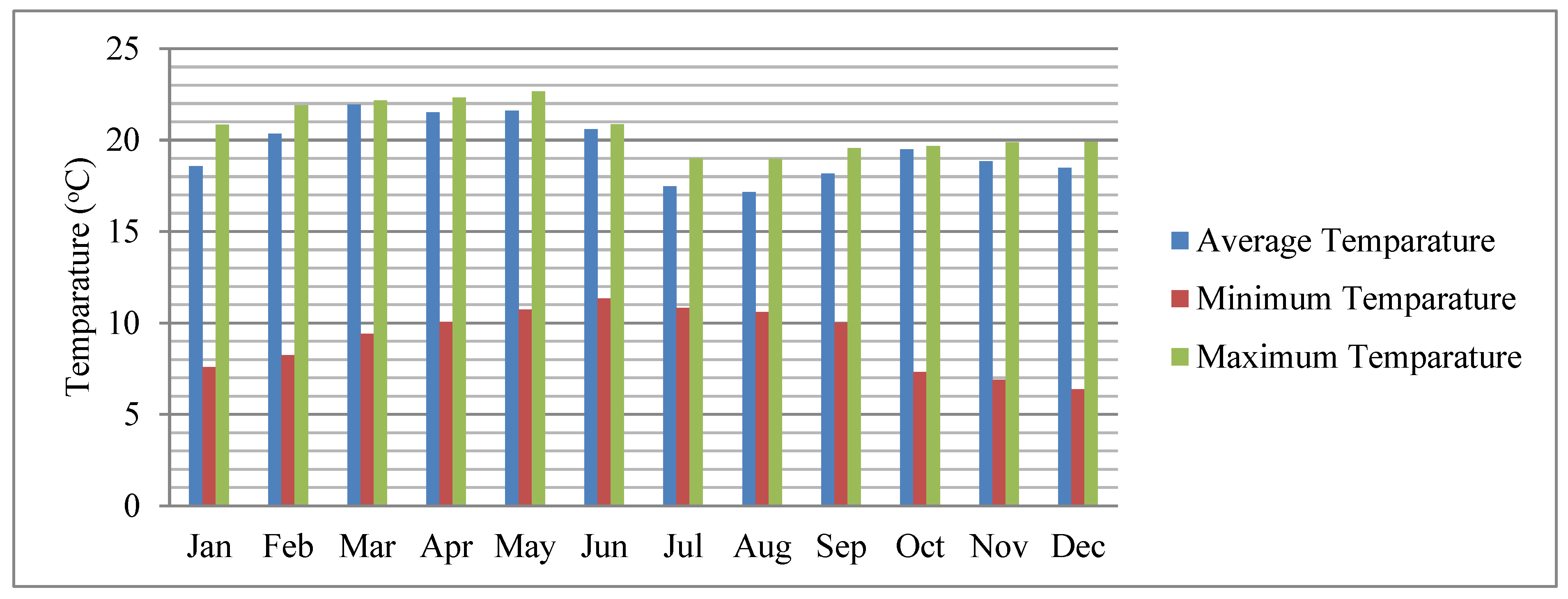
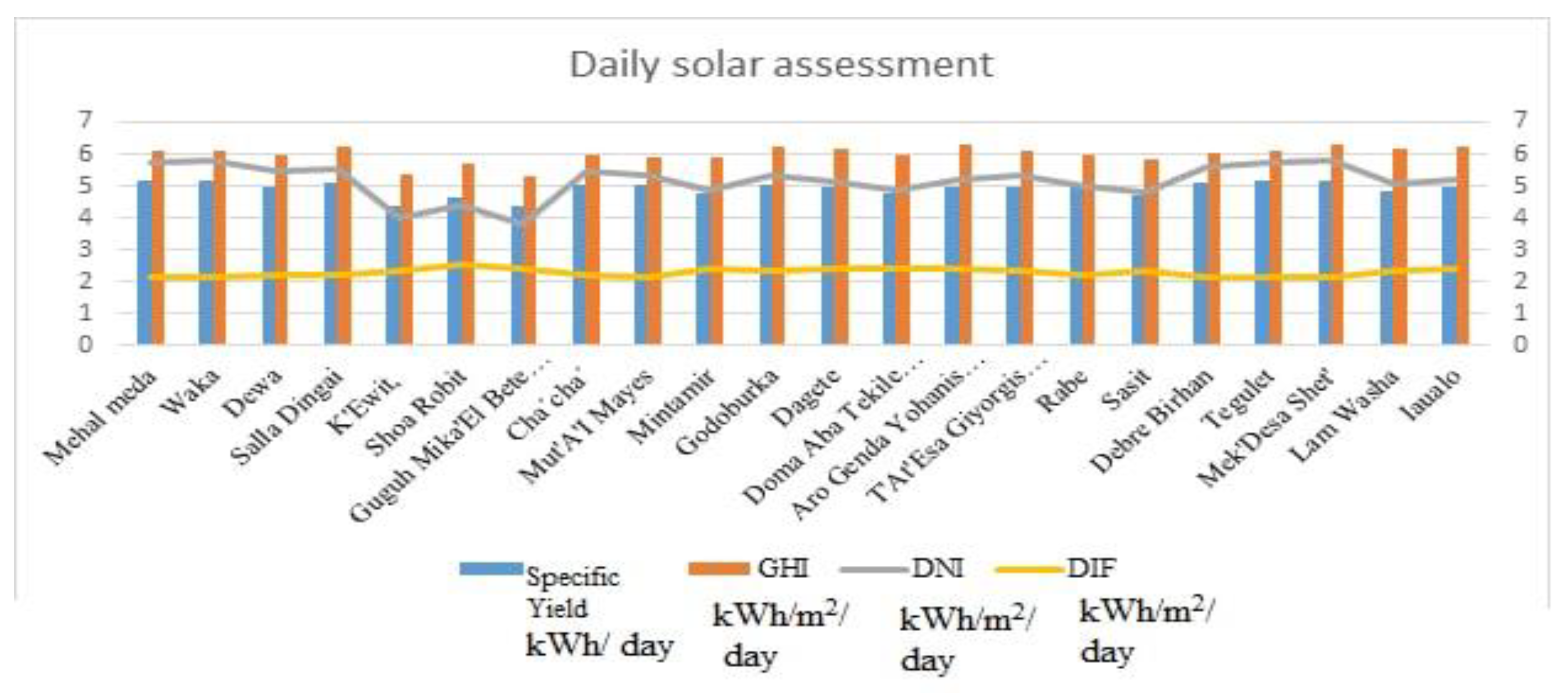

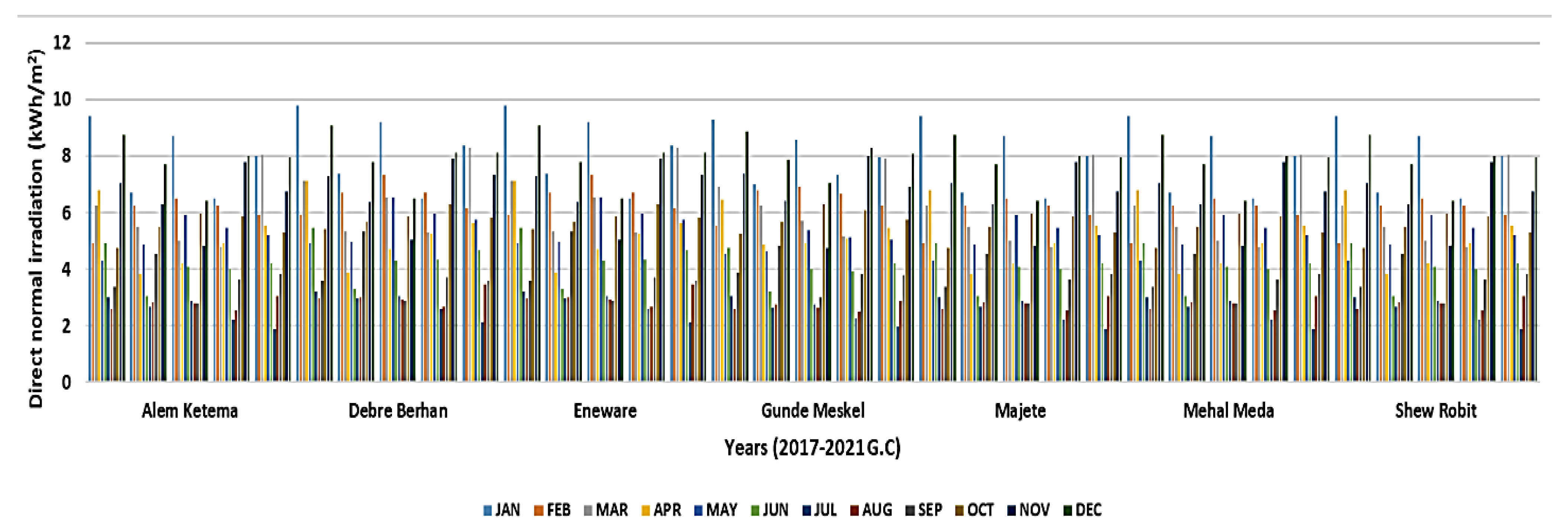
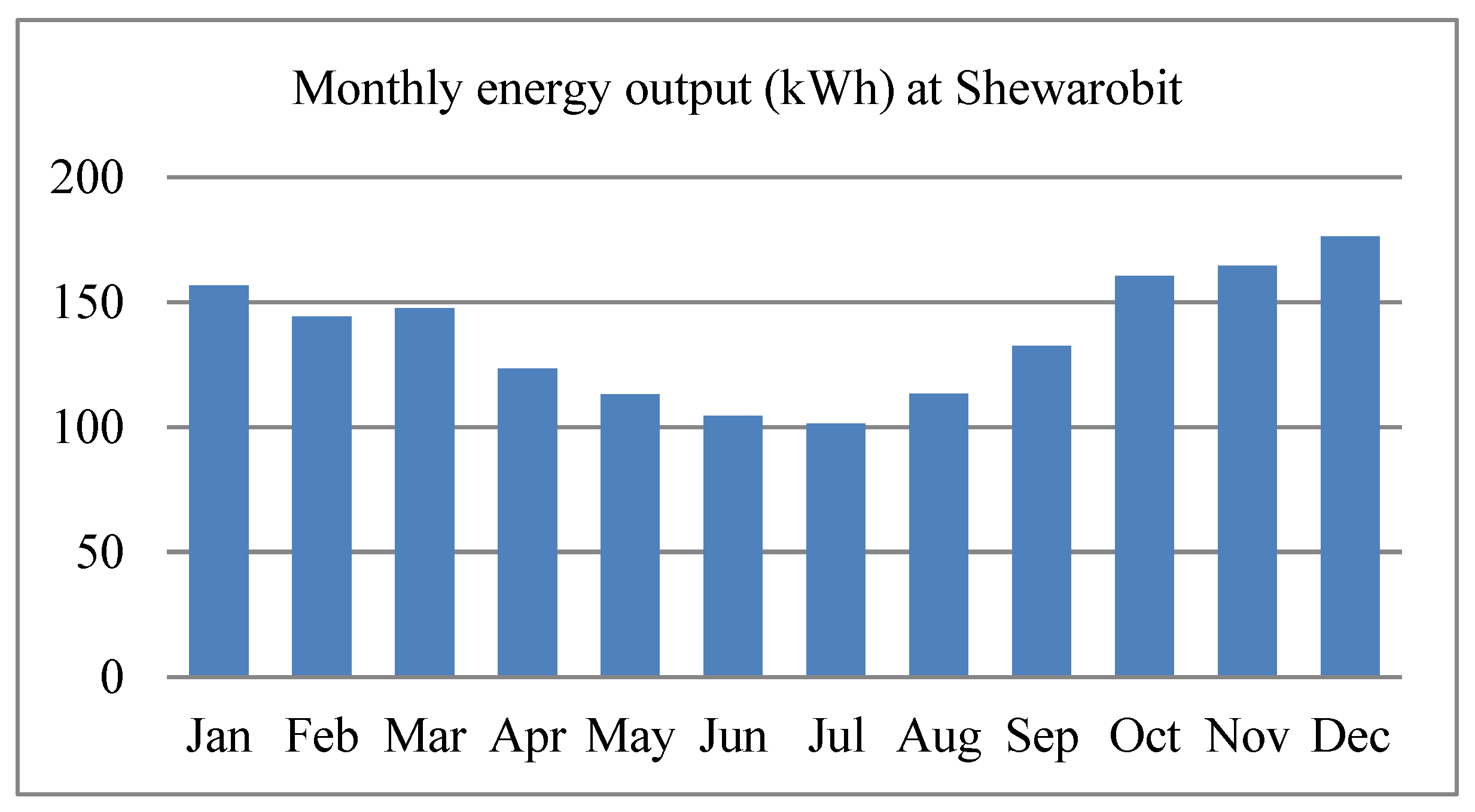
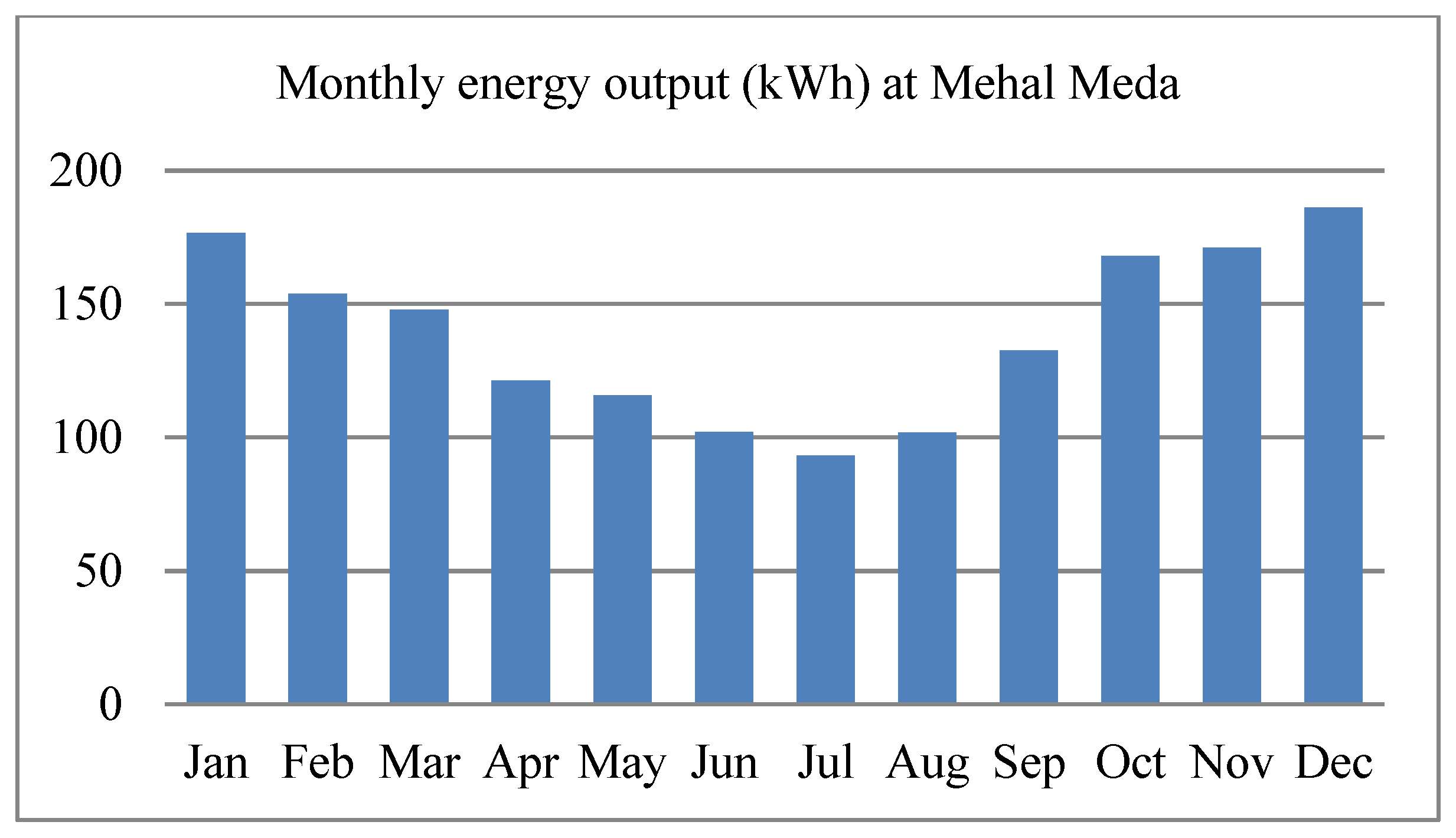
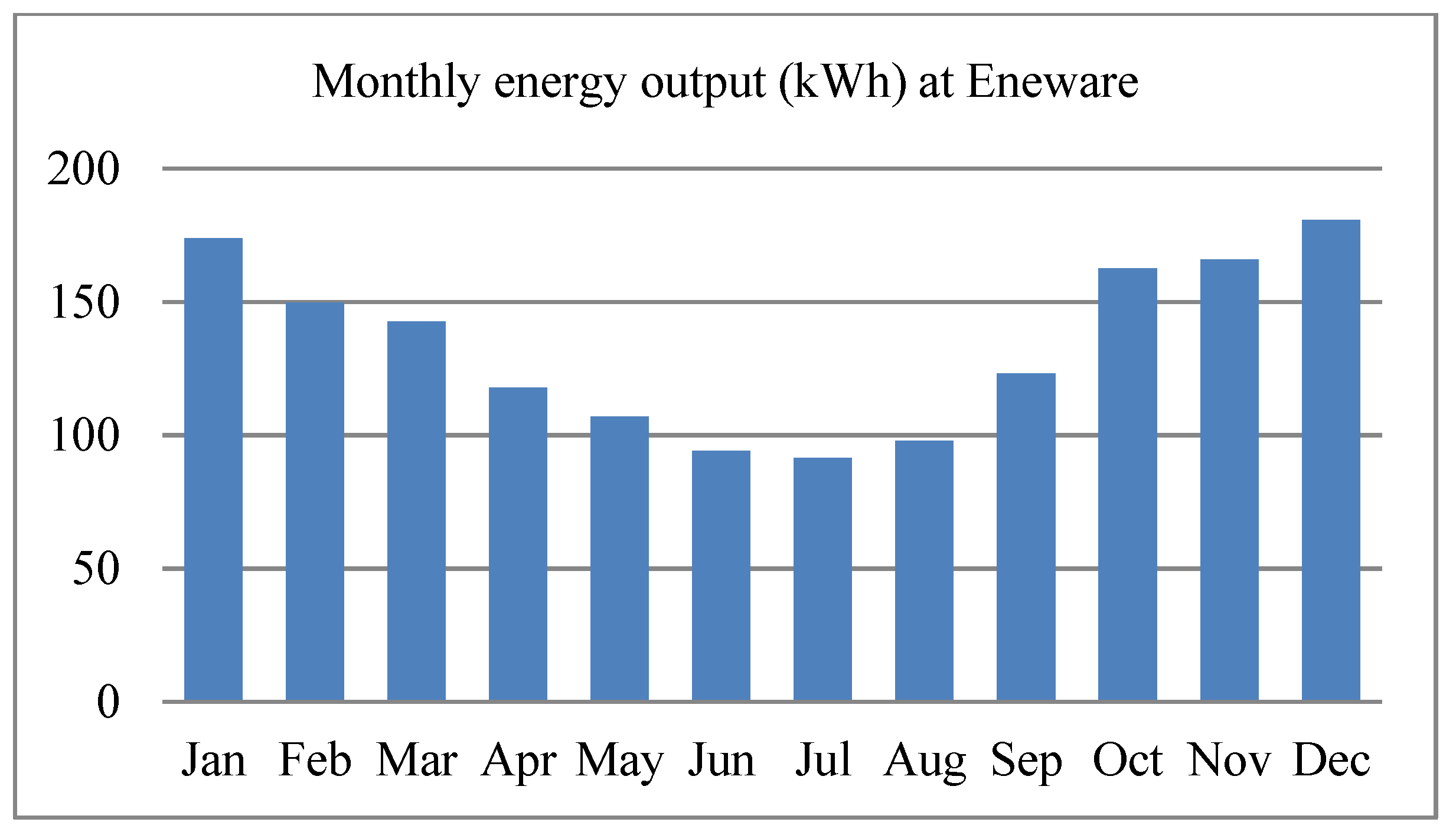
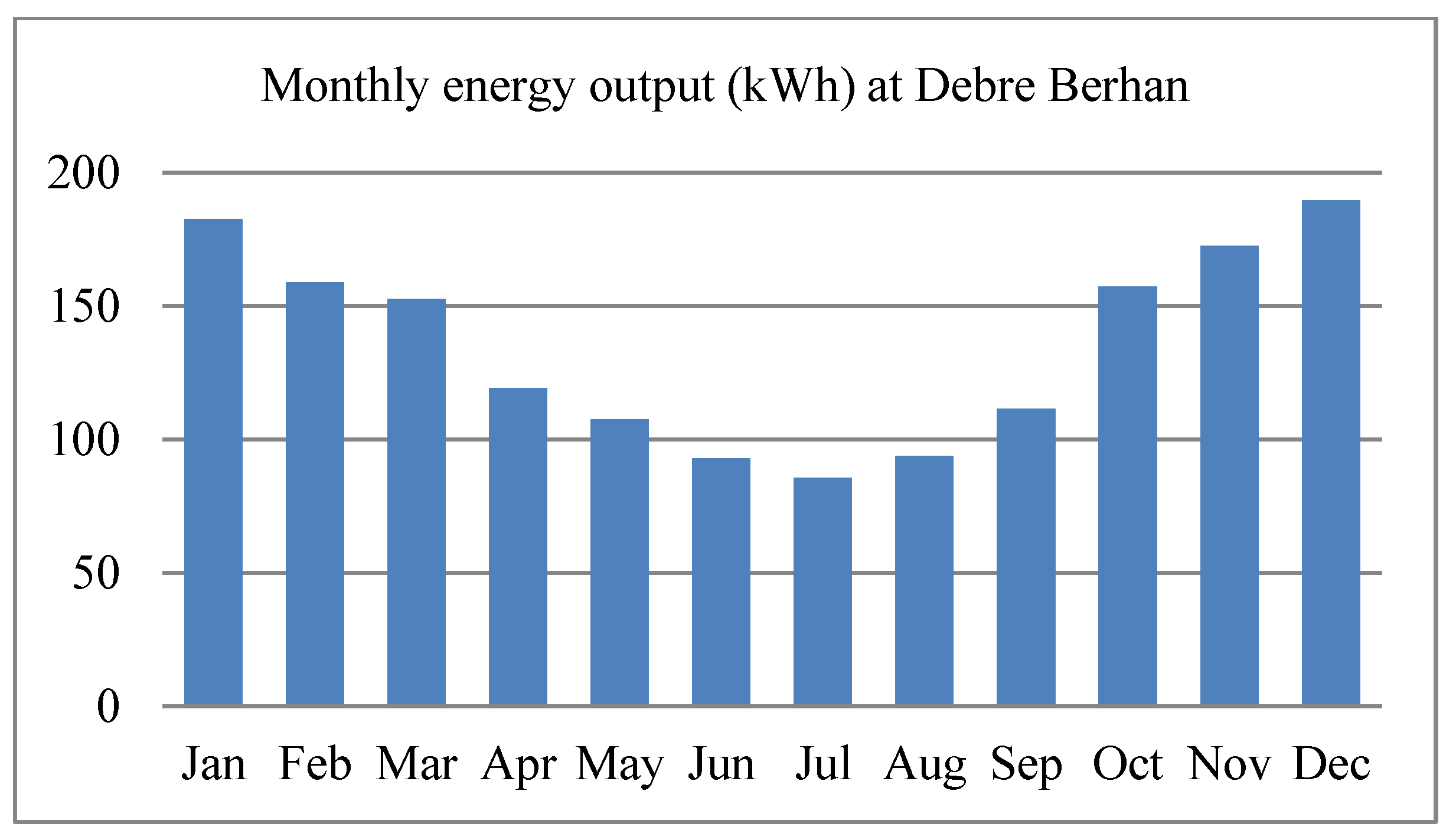
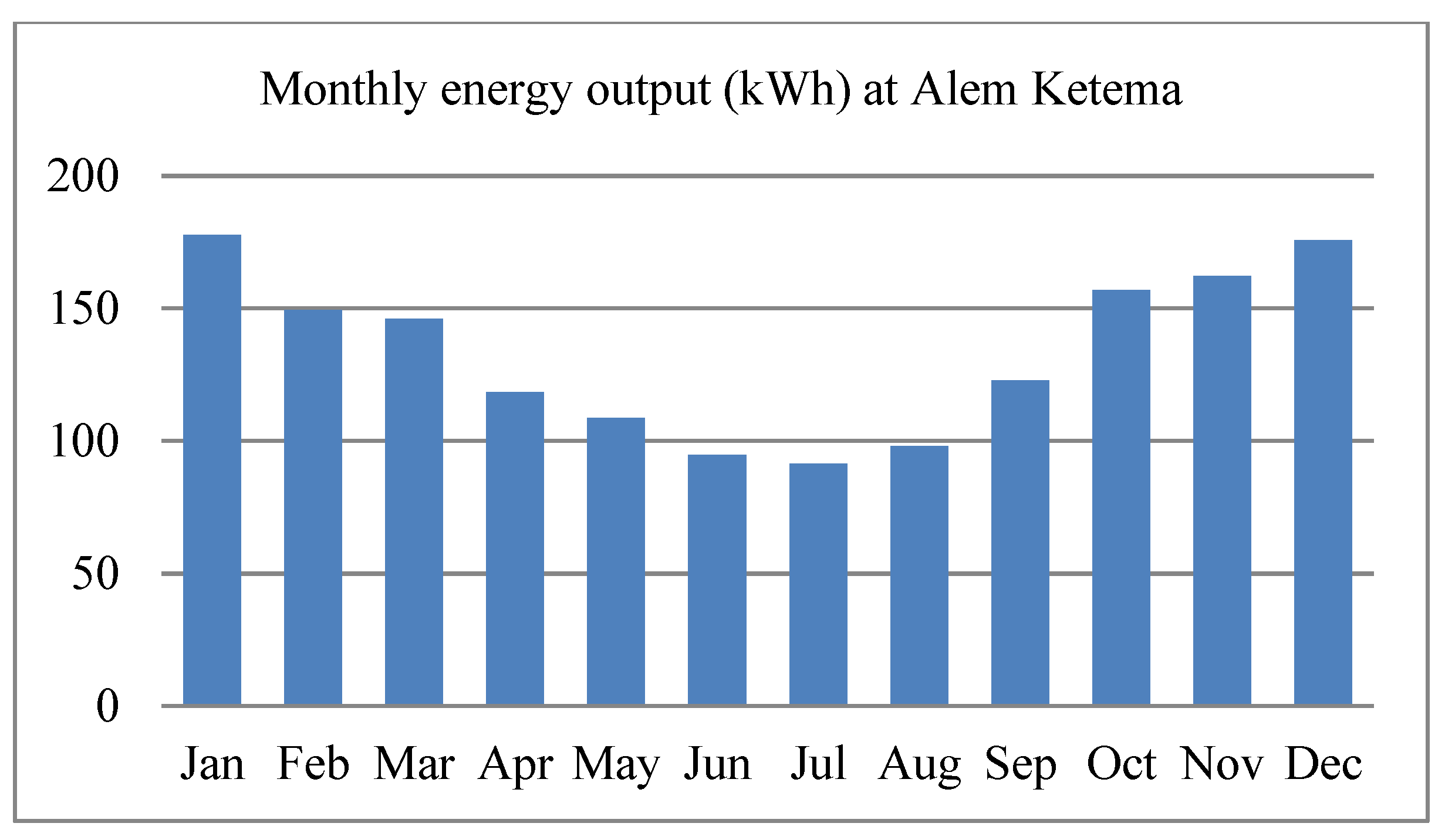
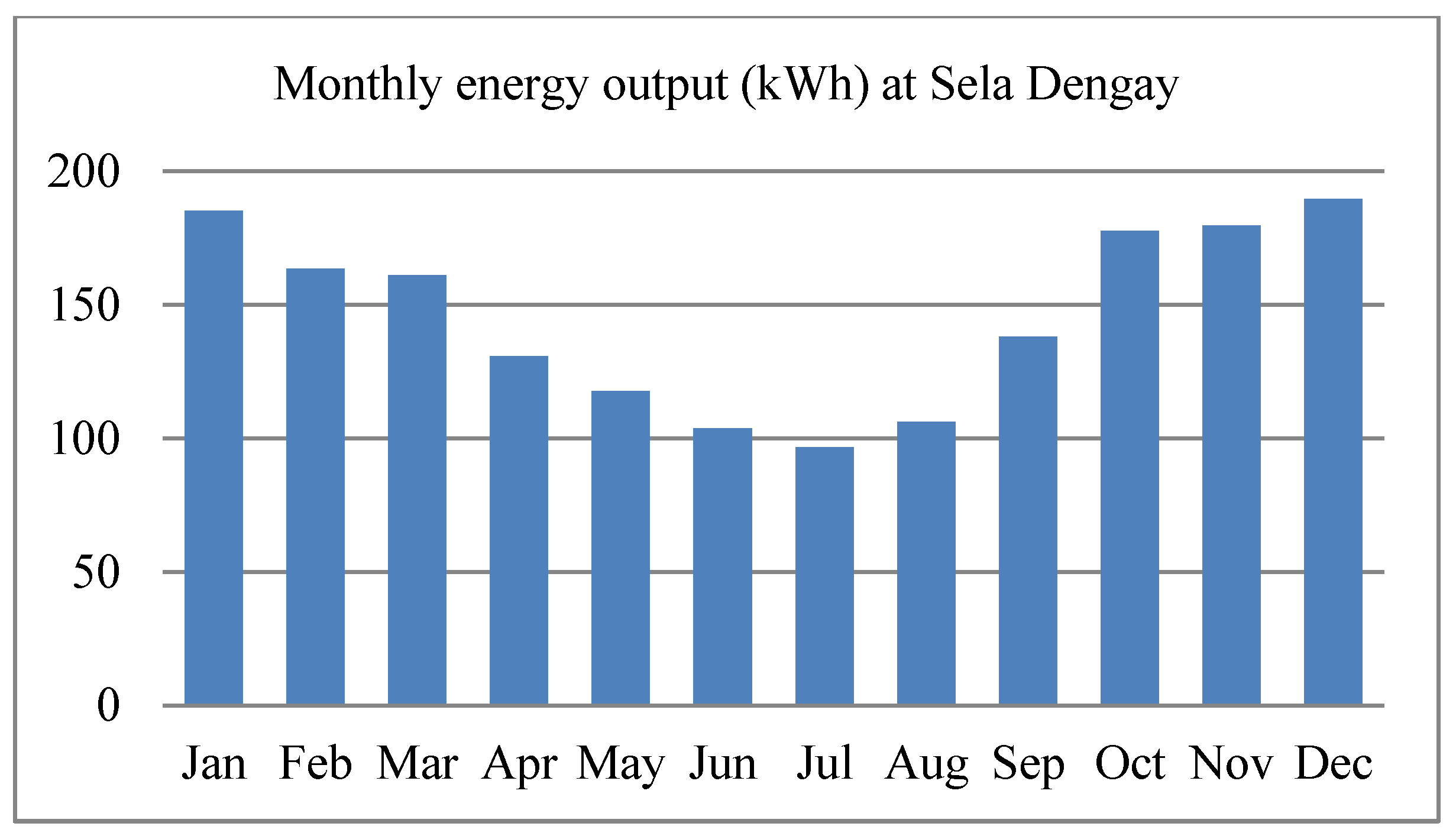
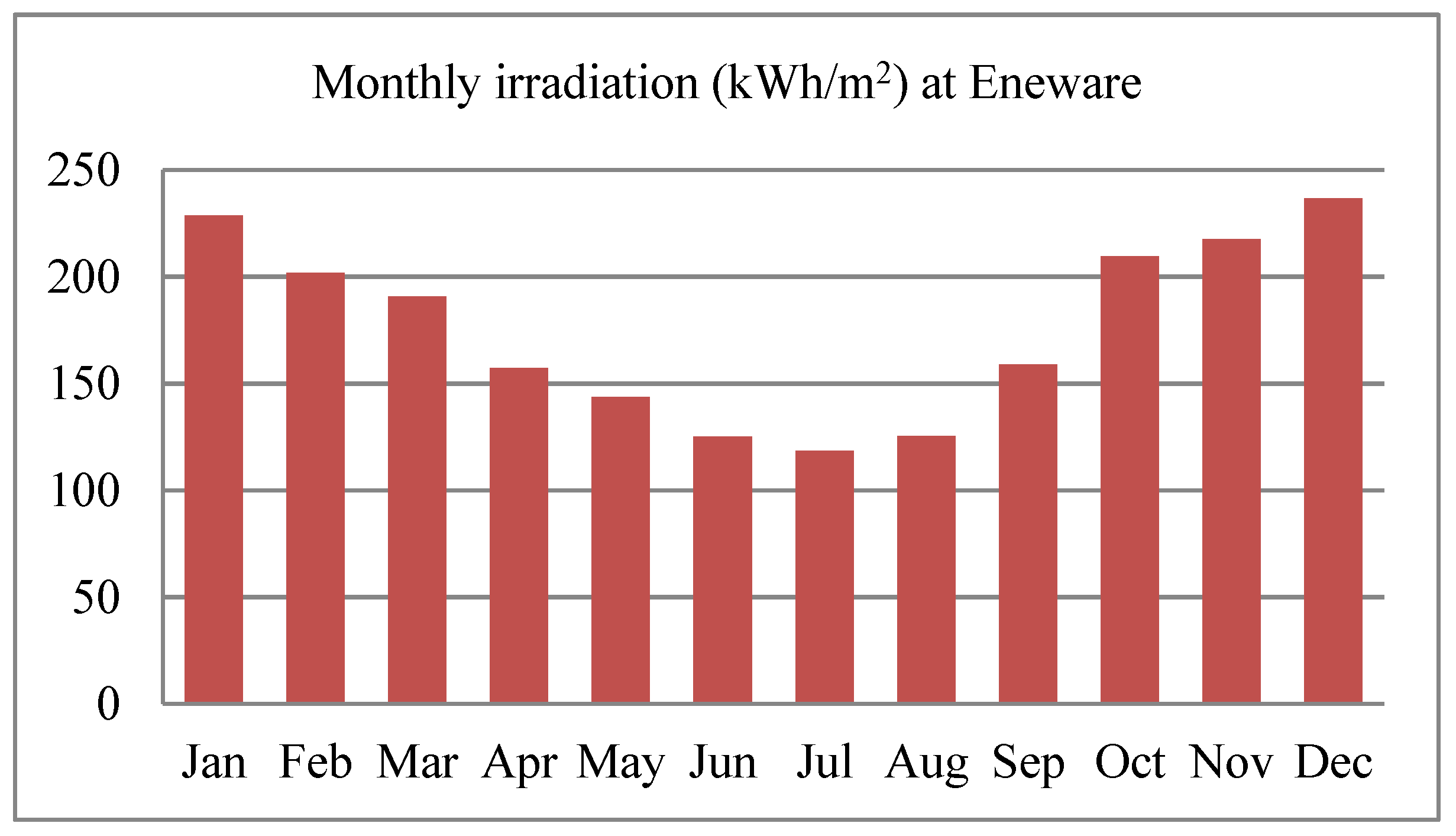
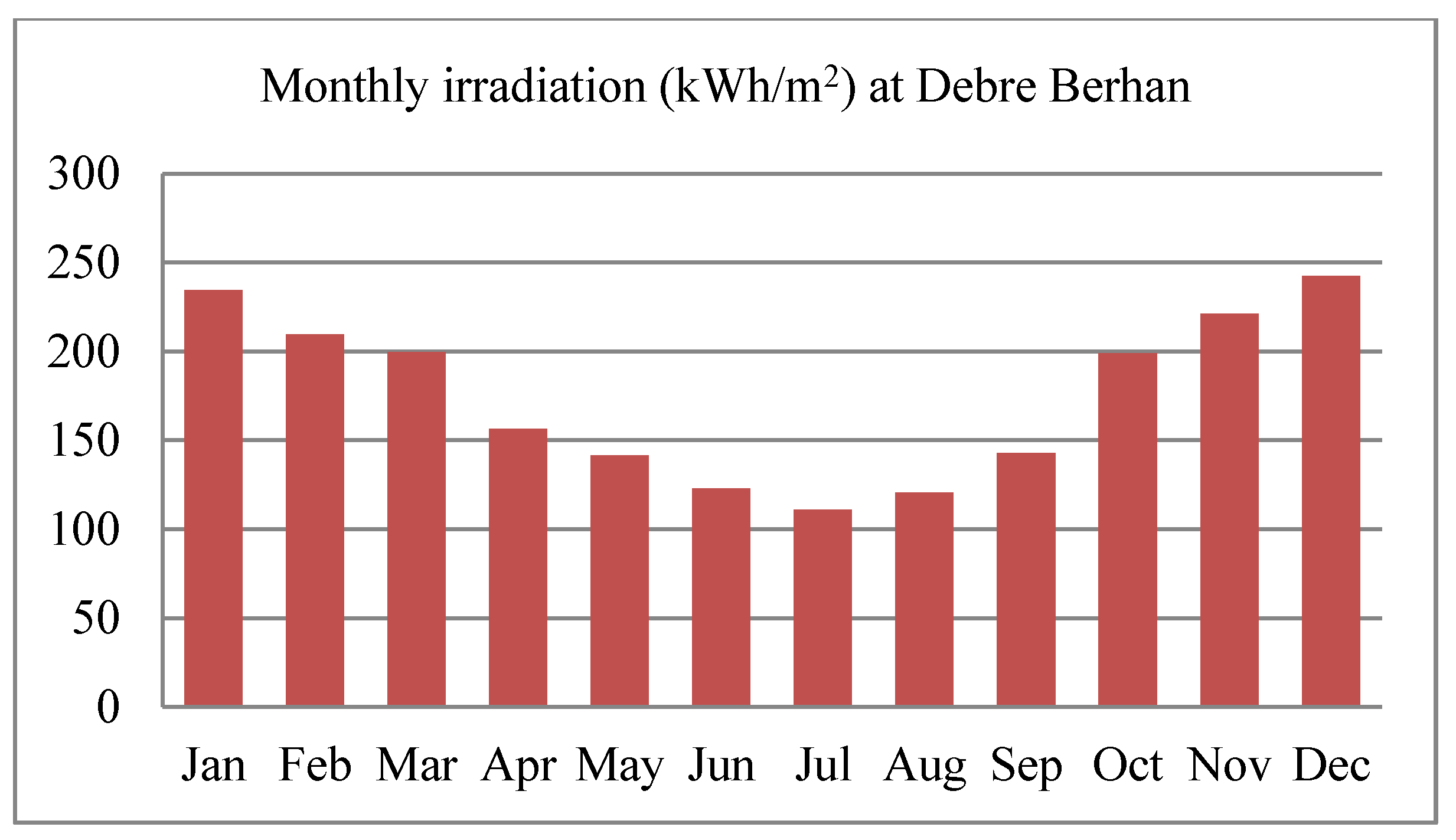
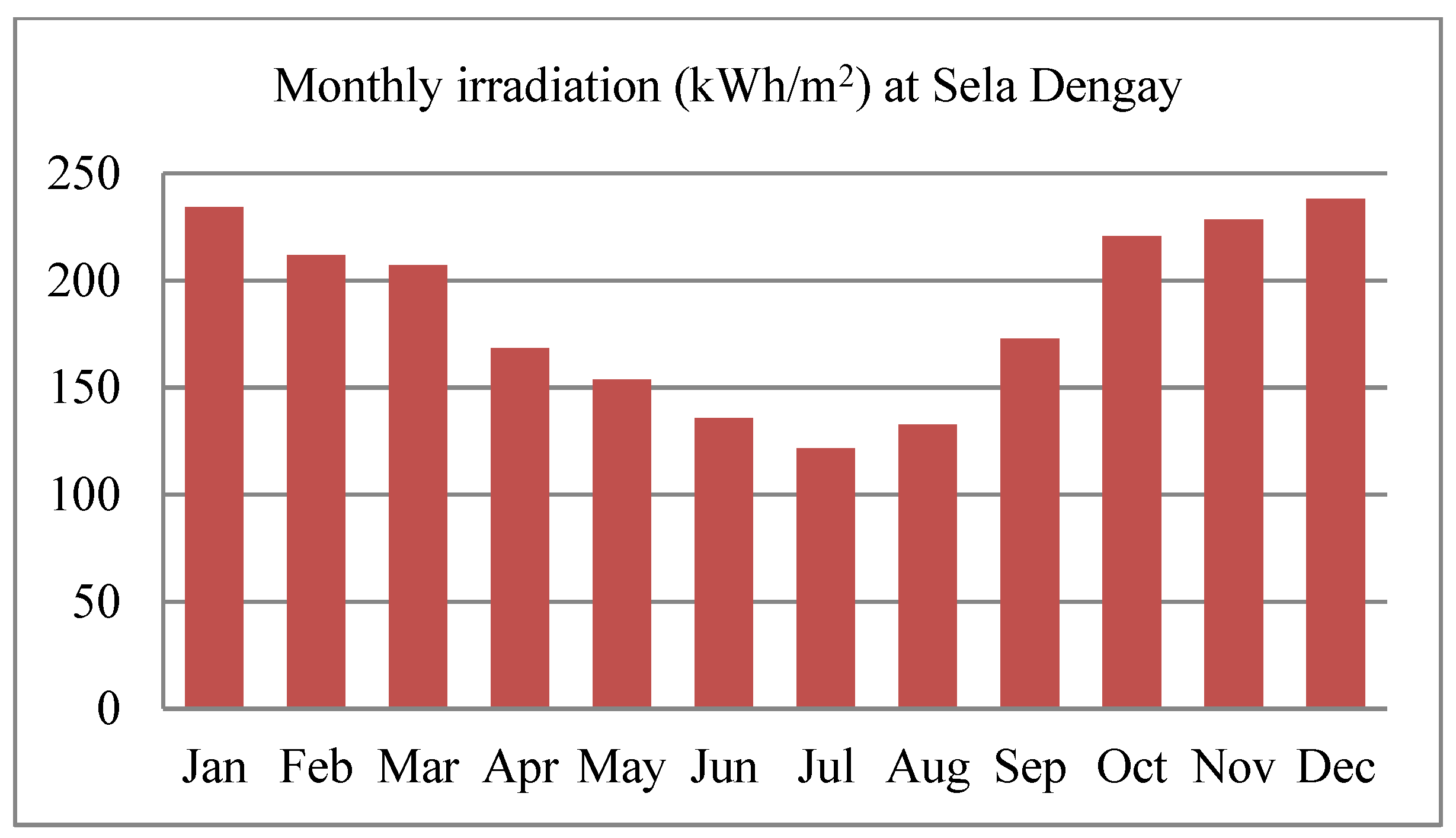
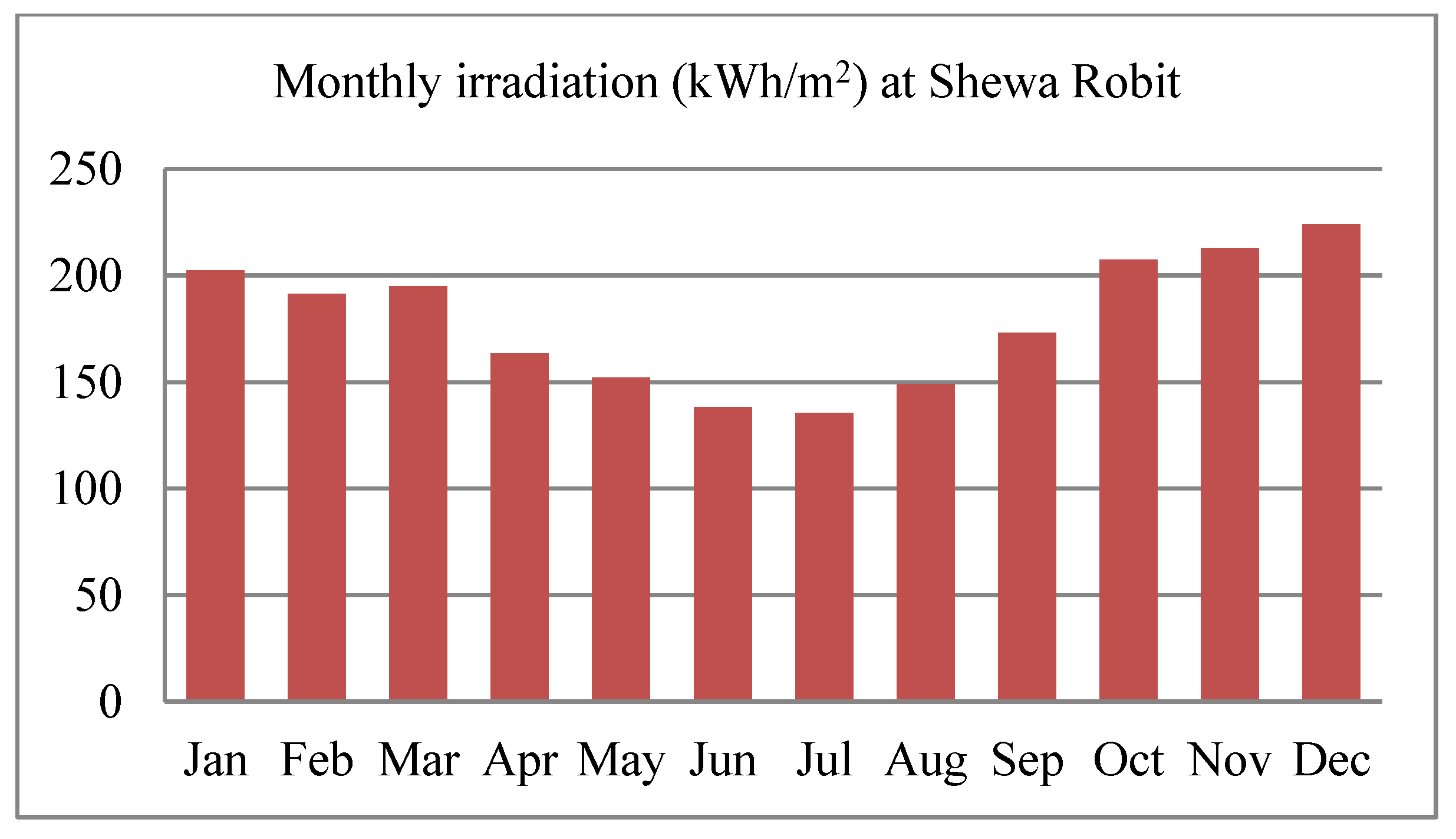
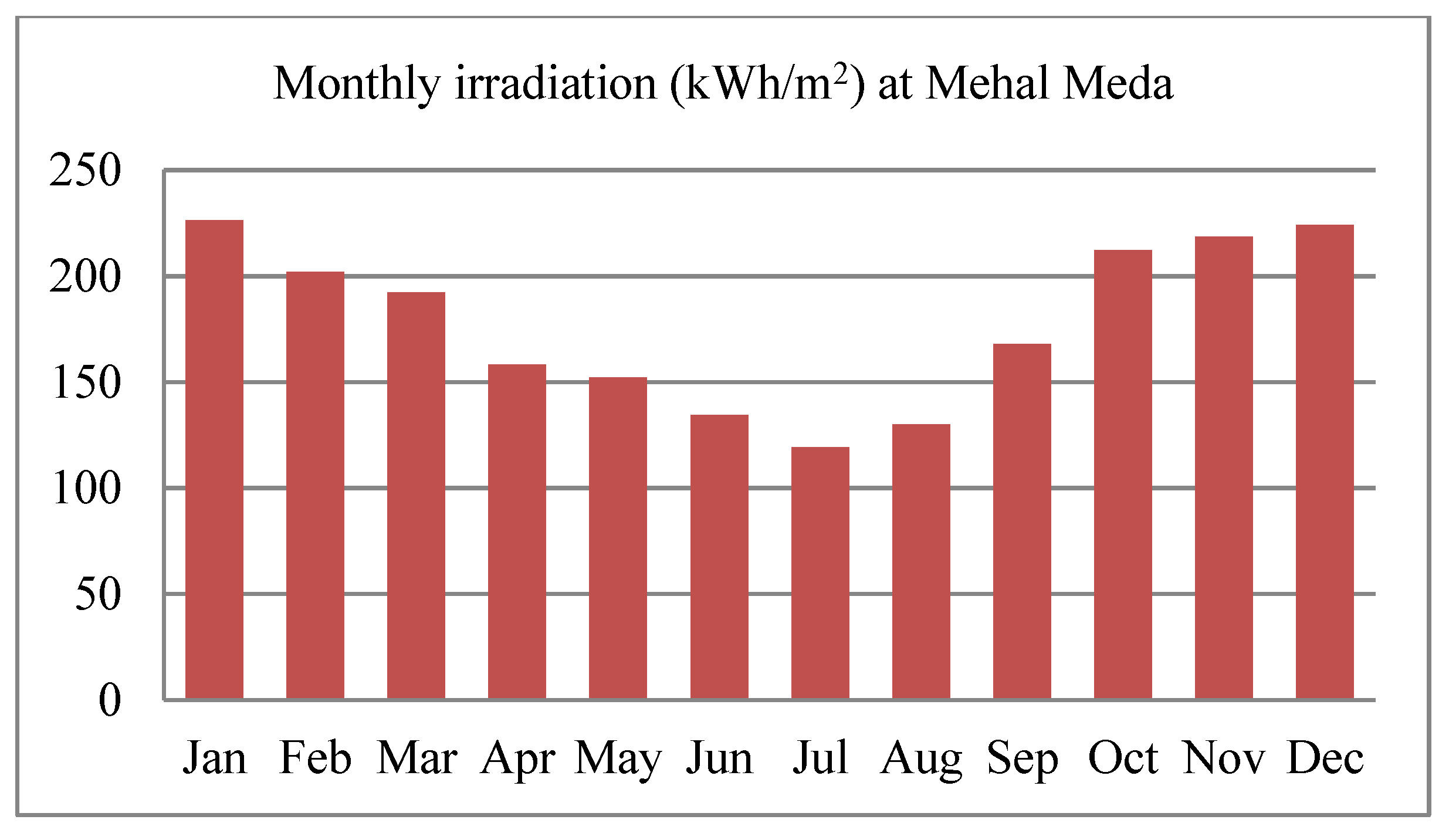
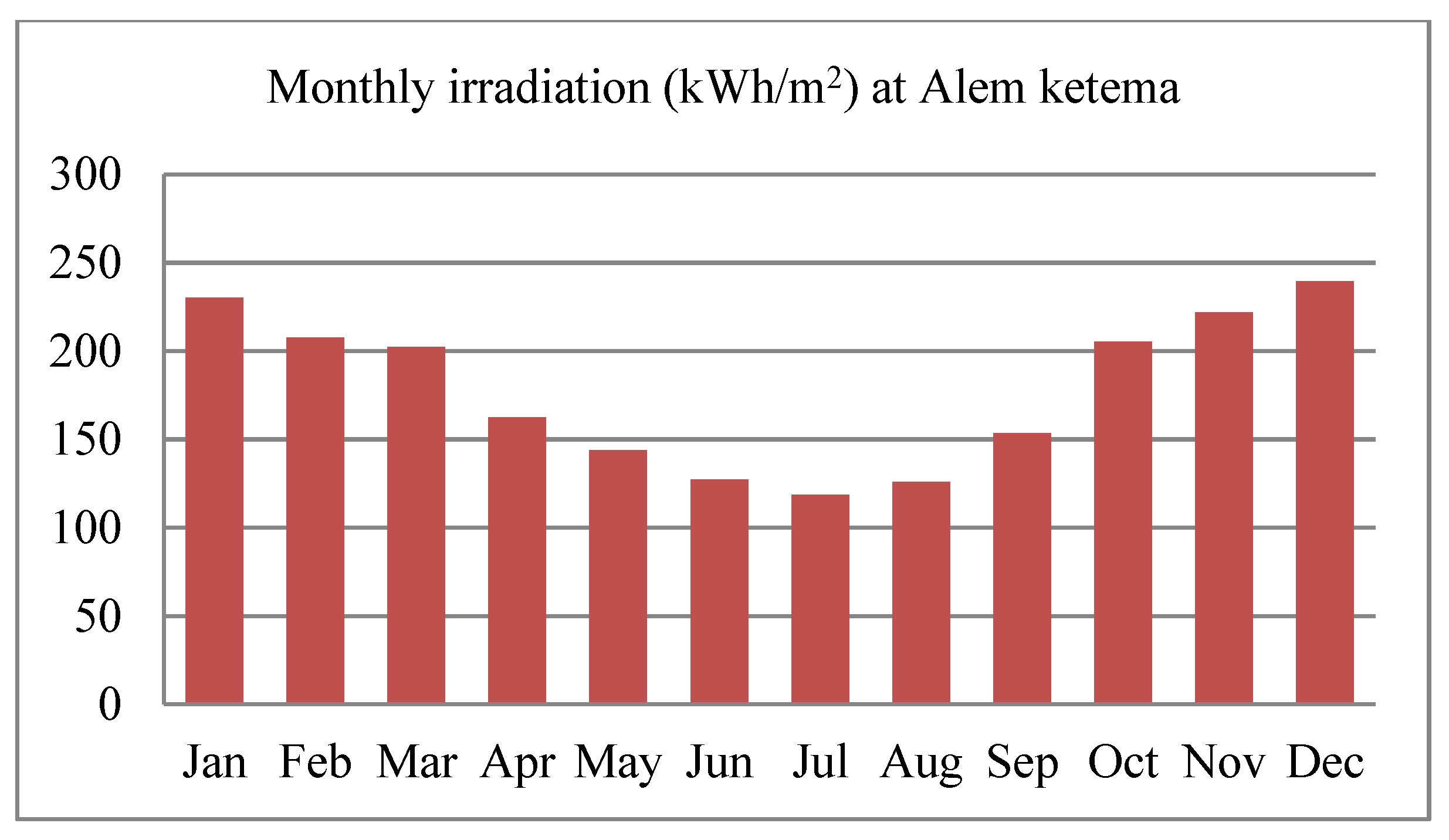
| Name | Specific Yield (kWh/m2/Year) | GHI (kWh/m2) | DNI (kWh/m2) | DIF (kWh/m2) | Temp (°C) | Latitude (°) | Longitude (°) |
|---|---|---|---|---|---|---|---|
| Mehal Meda | 1886 | 2222 | 2098 | 781.3 | 9.2 | 10.263573 | 39.71283 |
| Waka | 1885.9 | 2227.5 | 2115.9 | 779.4 | 9.9 | 10.183836 | 39.687424 |
| Dewa | 1806.8 | 2177.5 | 2002.6 | 808.7 | 11.6 | 10.139228 | 39.616699 |
| Sela Dengay | 1867.6 | 2284.5 | 2021.5 | 806.2 | 16.4 | 9.986433 | 39.634552 |
| K’ewit | 1595.4 | 1952.2 | 1453.3 | 855.4 | 13.4 | 10.150043 | 39.82132 |
| Shoa Robit | 1703.9 | 2091.9 | 1600.9 | 920.4 | 19.9 | 10.033767 | 39.868698 |
| GuguhMika’ElBeteKristiyan | 1594.9 | 1933.5 | 1394.8 | 873.6 | 15.8 | 9.75643 | 39.80278 |
| Cha’cha’ | 1833 | 2183.5 | 2007.2 | 795.6 | 12.5 | 9.553355 | 39.443665 |
| Mut’a’i Mayes | 1836.4 | 2151.9 | 1950.1 | 788.9 | 9.1 | 9.259358 | 39.484863 |
| Mintamir | 1748 | 2162.2 | 1784.3 | 880.5 | 19.6 | 9.110233 | 39.539795 |
| Godoburka | 1834.6 | 2286.5 | 1958.2 | 855.1 | 21 | 8.91492 | 39.570007 |
| Dagete | 1802.9 | 2245.2 | 1867.6 | 878.6 | 21.5 | 9.186159 | 39.767761 |
| Doma Aba Tekile Bete Kristiyan | 1752.6 | 2182 | 1783.1 | 882.8 | 19.1 | 9.492408 | 39.814453 |
| Aro Genda Yohanis Bete Kristiyan | 1825.4 | 2289.7 | 1900.3 | 888.5 | 23 | 9.974261 | 38.902588 |
| T’At’Esa Giyorgis Bete Kristiyan | 1824.9 | 2224.5 | 1947.4 | 843.8 | 15.6 | 9.849804 | 39.182739 |
| Rabe | 1840.8 | 2186.7 | 1834.2 | 797.7 | 16 | 10.563422 | 39.594727 |
| Sasit | 1709.7 | 2133.5 | 1757.7 | 855.8 | 21.9 | 9.914744 | 39.484863 |
| Debre Birhan | 1874.4 | 2208.4 | 2046.6 | 790.5 | 9.4 | 9.589917 | 39.660645 |
| Tegulet | 1893.2 | 2223.1 | 2085.1 | 783.4 | 9.6 | 9.557417 | 39.611206 |
| Mek’Desa Shet’ | 1877 | 2294.4 | 2112.9 | 791.8 | 15.6 | 9.860628 | 39.638672 |
| Lam Washa | 1776.8 | 2249.9 | 1840.8 | 864.1 | 23.3 | 9.979671 | 39.116821 |
| Iaualo | 1809.3 | 2284.7 | 1901.5 | 882.7 | 23.3 | 9.903921 | 39.028931 |
| No. | DNI in kWh/m2 | Remarks |
|---|---|---|
| 1 | <1600 | Not recommended |
| 2 | 1600–2000 | Recommended |
| 3 | >2000 | Good |
Disclaimer/Publisher’s Note: The statements, opinions and data contained in all publications are solely those of the individual author(s) and contributor(s) and not of MDPI and/or the editor(s). MDPI and/or the editor(s) disclaim responsibility for any injury to people or property resulting from any ideas, methods, instructions or products referred to in the content. |
© 2023 by the authors. Licensee MDPI, Basel, Switzerland. This article is an open access article distributed under the terms and conditions of the Creative Commons Attribution (CC BY) license (https://creativecommons.org/licenses/by/4.0/).
Share and Cite
Feleke, S.; Anteneh, D.; Pydi, B.; Satish, R.; El-Shahat, A.; Abdelaziz, A.Y. Feasibility and Potential Assessment of Solar Resources: A Case Study in North Shewa Zone, Amhara, Ethiopia. Energies 2023, 16, 2681. https://doi.org/10.3390/en16062681
Feleke S, Anteneh D, Pydi B, Satish R, El-Shahat A, Abdelaziz AY. Feasibility and Potential Assessment of Solar Resources: A Case Study in North Shewa Zone, Amhara, Ethiopia. Energies. 2023; 16(6):2681. https://doi.org/10.3390/en16062681
Chicago/Turabian StyleFeleke, Solomon, Degarege Anteneh, Balamurali Pydi, Raavi Satish, Adel El-Shahat, and Almoataz Y. Abdelaziz. 2023. "Feasibility and Potential Assessment of Solar Resources: A Case Study in North Shewa Zone, Amhara, Ethiopia" Energies 16, no. 6: 2681. https://doi.org/10.3390/en16062681
APA StyleFeleke, S., Anteneh, D., Pydi, B., Satish, R., El-Shahat, A., & Abdelaziz, A. Y. (2023). Feasibility and Potential Assessment of Solar Resources: A Case Study in North Shewa Zone, Amhara, Ethiopia. Energies, 16(6), 2681. https://doi.org/10.3390/en16062681







